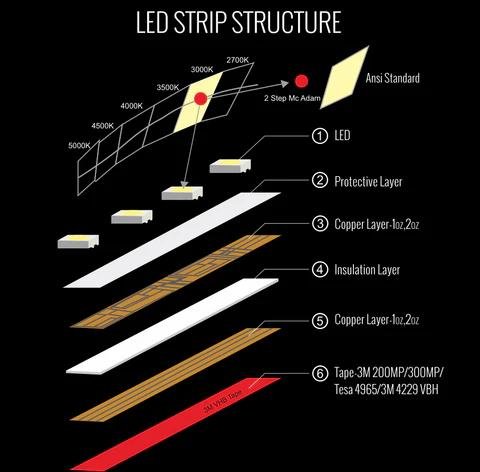Dream Light Technology Limited help you know more about the Structure of LED Strip Lights.
Introduction
LED strip lights have become increasingly popular due to their versatility, energy efficiency, and ease of installation. Whether you’re looking to add some ambiance to your living space or need functional lighting for a workspace, understanding the structure of LED strip lights can help you make informed decisions. In this blog, we’ll break down the components and features of LED strip lights to give you a comprehensive understanding of how they work.

1. The Basics of LED Technology
LED (Light Emitting Diode) technology has revolutionized lighting. LEDs are semiconductor devices that emit light when an electric current passes through them. Compared to traditional lighting options, LEDs are more energy-efficient, have a longer lifespan, and are available in a wide range of colors.
2. Components of LED Strip Lights
2.1. LED Chips
The core of any LED strip light is the LED chips themselves. These tiny light sources are typically mounted in series along the strip. The size, type, and number of LED chips per meter can vary, affecting the brightness and color of the light produced.
2.2. Flexible Circuit Board
LED chips are mounted on a flexible circuit board, usually made of a material like polyimide or polyester. This flexibility allows the strip to be bent and shaped to fit various applications. The circuit board also contains the electrical connections that power the LEDs.
2.3. Resistors
Resistors are used to regulate the current flowing through the LED chips, ensuring they operate within safe parameters. Each LED chip requires a specific current to function correctly, and resistors help manage this.
2.4. Adhesive Backing
Many LED strip lights come with an adhesive backing, making installation quick and easy. The adhesive is typically strong enough to hold the strip in place on various surfaces, such as walls, ceilings, or under cabinets.
2.5. Protective Coating
To protect the LED chips and circuit board from dust, moisture, and physical damage, many LED strips are coated with a protective layer, such as silicone or epoxy. This coating can make the strips suitable for outdoor use or in humid environments like bathrooms.

3. Types of LED Strip Lights
3.1. Single-Color LED Strips
These strips emit light of a single color, typically available in white (warm, neutral, or cool), red, blue, green, or other colors. They are commonly used for task lighting, accent lighting, or as a decorative element.
3.2. RGB LED Strips
RGB (Red, Green, Blue) LED strips contain tri-color LED chips that can produce a wide range of colors by mixing these three primary colors. They are popular for creating dynamic lighting effects and can be controlled to change colors, flash, or fade.
3.3. RGBW LED Strips
RGBW strips include an additional white LED chip along with the RGB chips, providing a more accurate white light and expanding the range of colors. These strips offer greater versatility in lighting design.
3.4. Addressable LED Strips
Addressable LED strips allow for individual control of each LED chip, enabling complex lighting effects like chasing, flowing, or animated patterns. These are often used in more advanced lighting projects and are controlled via special controllers or software.
4. Powering LED Strip Lights
4.1. Power Supplies
LED strip lights require a power supply that converts the mains voltage (120V or 240V) to a lower DC voltage, typically 12V or 24V. The power supply must match the voltage requirements of the strip and provide enough current to power all the LEDs.
4.2. Controllers
For RGB, RGBW, and addressable strips, a controller is needed to manage the colors and effects. These controllers can be simple remote controls or more advanced units with Wi-Fi or Bluetooth connectivity for smartphone app control.
5. Installation Tips
- Measure the Area: Before cutting or installing, measure the area where you plan to place the LED strip to ensure a proper fit.
- Clean the Surface: Ensure the surface is clean and dry before applying the adhesive backing.
- Cutting and Connecting: Most LED strips can be cut at designated points and connected with special connectors to fit different spaces.
- Avoid Overloading: Ensure your power supply can handle the total wattage of the LED strip to avoid overloading and potential damage.

Conclusion
LED strip lights are a versatile and energy-efficient lighting solution for a wide range of applications. By understanding their structure and components, you can choose the right type of strip light for your needs and install them correctly for optimal performance. Whether for home decor, task lighting, or creative projects, LED strip lights offer endless possibilities.
